Attracting and Retaining Staff in Hospitality Industry: Key Strategies and Practices
VerifiedAdded on 2023/06/03
|12
|3574
|83
AI Summary
This essay discusses the importance of attracting and retaining quality staff in the hospitality industry. It evaluates strategies and practices to plan, recruit, attract, develop and motivate employees while responding towards external business environment and understanding contemporary HRM issues.
Contribute Materials
Your contribution can guide someone’s learning journey. Share your
documents today.
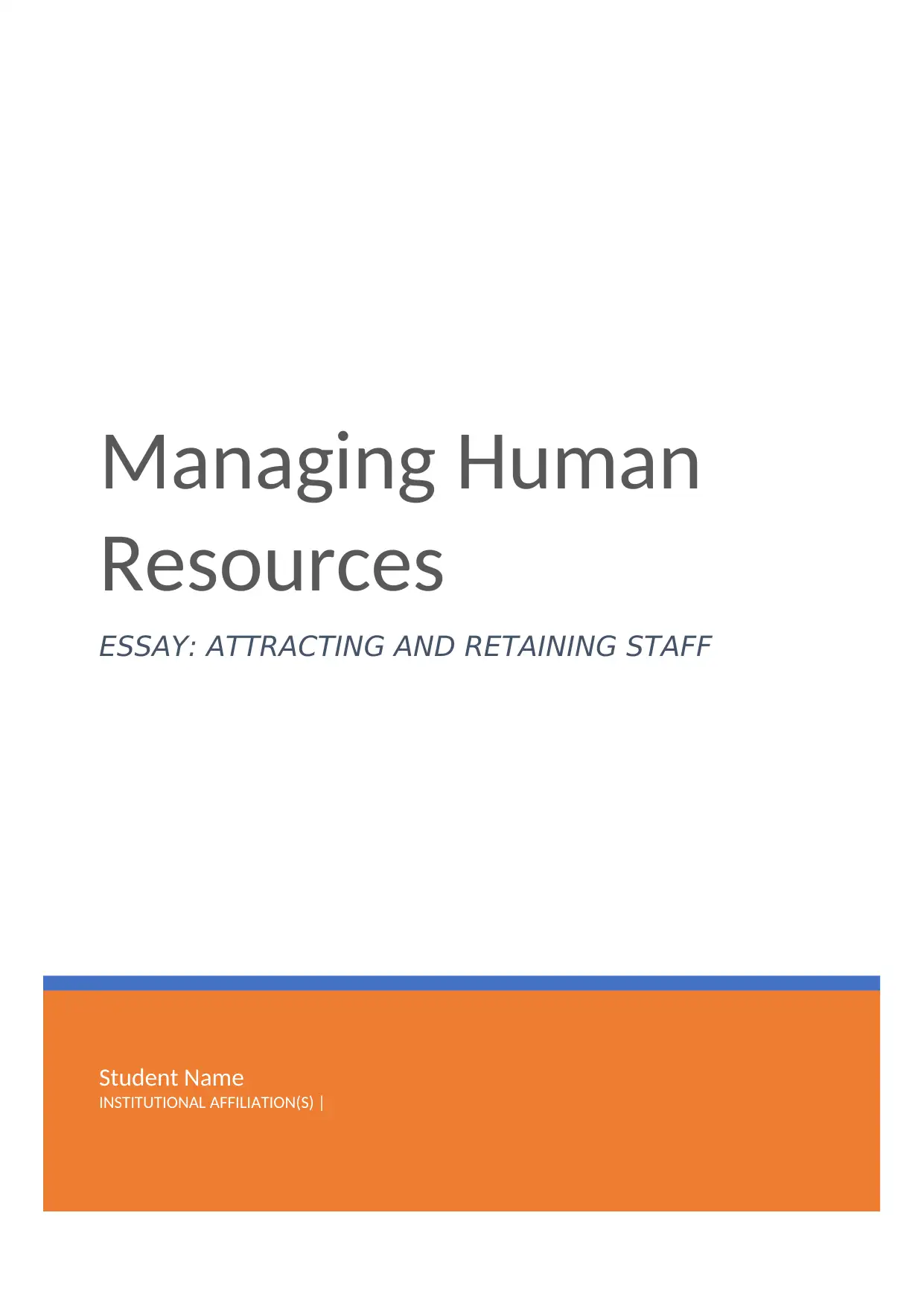
Student Name
INSTITUTIONAL AFFILIATION(S) |
Managing Human
Resources
ESSAY: ATTRACTING AND RETAINING STAFF
INSTITUTIONAL AFFILIATION(S) |
Managing Human
Resources
ESSAY: ATTRACTING AND RETAINING STAFF
Secure Best Marks with AI Grader
Need help grading? Try our AI Grader for instant feedback on your assignments.

P a g e | 1
Essay: Attracting and retaining staff
In organisations, human resource management (HRM) is basically concerned with
people management or it can be said that HRM is an employee support junction of
organisations (Ali, 2013). The primary functions of HRM is to consider human resource
related issues or get involved in matter related to line employees for producing organisational
goods and services. In every sector, organisations are comprised of human and to acquire
services, develop necessary skills and motivate for superior work performance, HR managers
play a significant role. Regardless of the sector organisation are working in, whether public or
private, attracting and retaining quality staff is very important for the smooth functioning of
business (Deshwal, 2015). HRM deals with staffing, motivation, development and training of
employees to attain, prepare, stimulate and retain them. While going through the articles
related to attraction and retention of staff in general, it was found that hospitality industry in
every country faced additional challenges as compared to other sectors concerning attraction
and retention of employees. To analyse the same this essay will draw upon key learnings
from the key themes of the semester i.e. selection and recruitment, training and development,
work life balance, performance management and employment relationship management. This
essay will identify and evaluate strategies and practices to plan, recruit, attract, develop and
motivate employees while responding towards external business environment and
understanding contemporary HRM issues especially in hospitality industry.
Composition and size of employees is of great concern in every organisation.
According to Khan, et al. (2011, workforce training and development is a significant issue
that requires critical attention especially in hospitality industry where organisations must
include skill development and training programs. Performance management as well as
Essay: Attracting and retaining staff
In organisations, human resource management (HRM) is basically concerned with
people management or it can be said that HRM is an employee support junction of
organisations (Ali, 2013). The primary functions of HRM is to consider human resource
related issues or get involved in matter related to line employees for producing organisational
goods and services. In every sector, organisations are comprised of human and to acquire
services, develop necessary skills and motivate for superior work performance, HR managers
play a significant role. Regardless of the sector organisation are working in, whether public or
private, attracting and retaining quality staff is very important for the smooth functioning of
business (Deshwal, 2015). HRM deals with staffing, motivation, development and training of
employees to attain, prepare, stimulate and retain them. While going through the articles
related to attraction and retention of staff in general, it was found that hospitality industry in
every country faced additional challenges as compared to other sectors concerning attraction
and retention of employees. To analyse the same this essay will draw upon key learnings
from the key themes of the semester i.e. selection and recruitment, training and development,
work life balance, performance management and employment relationship management. This
essay will identify and evaluate strategies and practices to plan, recruit, attract, develop and
motivate employees while responding towards external business environment and
understanding contemporary HRM issues especially in hospitality industry.
Composition and size of employees is of great concern in every organisation.
According to Khan, et al. (2011, workforce training and development is a significant issue
that requires critical attention especially in hospitality industry where organisations must
include skill development and training programs. Performance management as well as
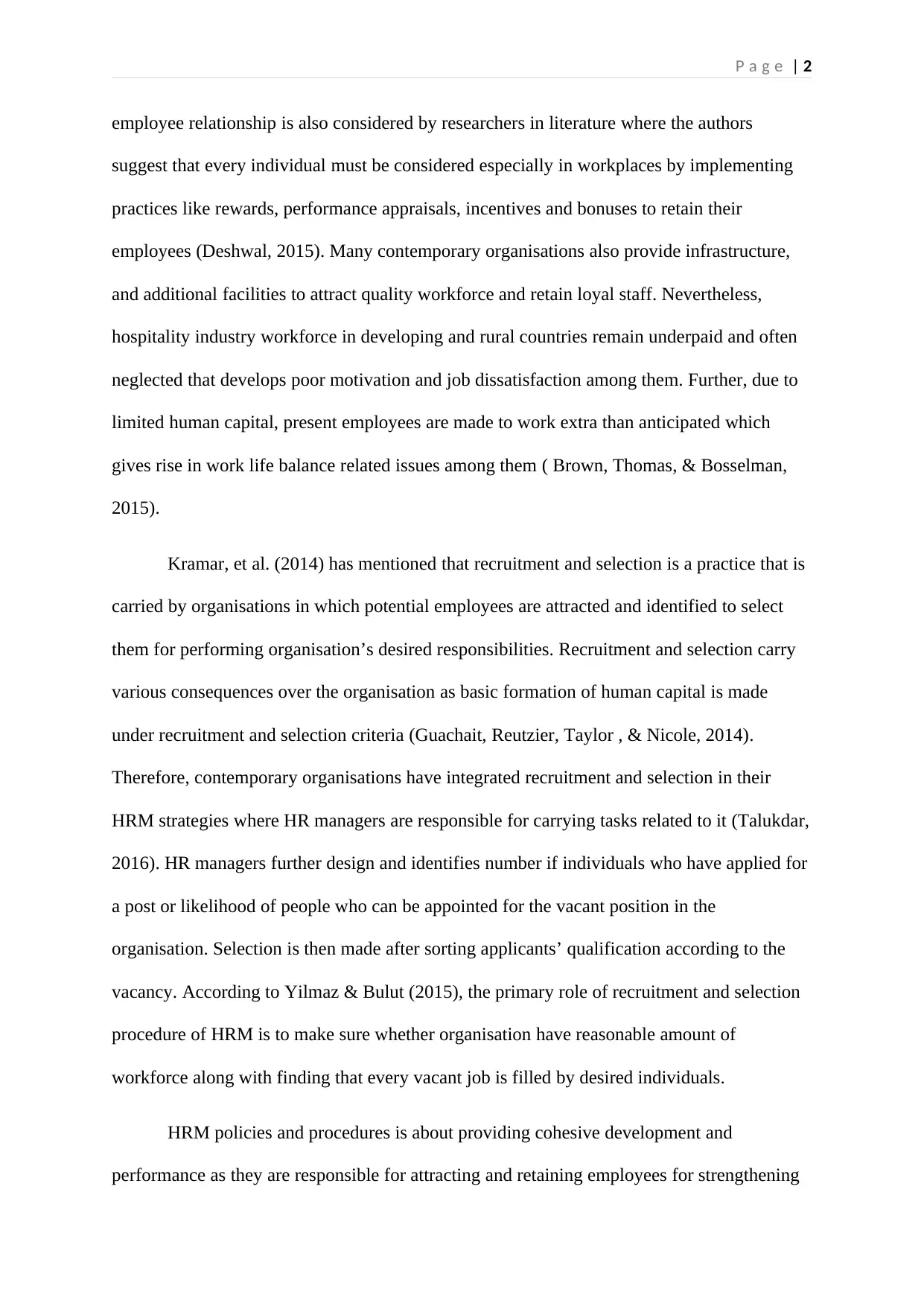
P a g e | 2
employee relationship is also considered by researchers in literature where the authors
suggest that every individual must be considered especially in workplaces by implementing
practices like rewards, performance appraisals, incentives and bonuses to retain their
employees (Deshwal, 2015). Many contemporary organisations also provide infrastructure,
and additional facilities to attract quality workforce and retain loyal staff. Nevertheless,
hospitality industry workforce in developing and rural countries remain underpaid and often
neglected that develops poor motivation and job dissatisfaction among them. Further, due to
limited human capital, present employees are made to work extra than anticipated which
gives rise in work life balance related issues among them ( Brown, Thomas, & Bosselman,
2015).
Kramar, et al. (2014) has mentioned that recruitment and selection is a practice that is
carried by organisations in which potential employees are attracted and identified to select
them for performing organisation’s desired responsibilities. Recruitment and selection carry
various consequences over the organisation as basic formation of human capital is made
under recruitment and selection criteria (Guachait, Reutzier, Taylor , & Nicole, 2014).
Therefore, contemporary organisations have integrated recruitment and selection in their
HRM strategies where HR managers are responsible for carrying tasks related to it (Talukdar,
2016). HR managers further design and identifies number if individuals who have applied for
a post or likelihood of people who can be appointed for the vacant position in the
organisation. Selection is then made after sorting applicants’ qualification according to the
vacancy. According to Yilmaz & Bulut (2015), the primary role of recruitment and selection
procedure of HRM is to make sure whether organisation have reasonable amount of
workforce along with finding that every vacant job is filled by desired individuals.
HRM policies and procedures is about providing cohesive development and
performance as they are responsible for attracting and retaining employees for strengthening
employee relationship is also considered by researchers in literature where the authors
suggest that every individual must be considered especially in workplaces by implementing
practices like rewards, performance appraisals, incentives and bonuses to retain their
employees (Deshwal, 2015). Many contemporary organisations also provide infrastructure,
and additional facilities to attract quality workforce and retain loyal staff. Nevertheless,
hospitality industry workforce in developing and rural countries remain underpaid and often
neglected that develops poor motivation and job dissatisfaction among them. Further, due to
limited human capital, present employees are made to work extra than anticipated which
gives rise in work life balance related issues among them ( Brown, Thomas, & Bosselman,
2015).
Kramar, et al. (2014) has mentioned that recruitment and selection is a practice that is
carried by organisations in which potential employees are attracted and identified to select
them for performing organisation’s desired responsibilities. Recruitment and selection carry
various consequences over the organisation as basic formation of human capital is made
under recruitment and selection criteria (Guachait, Reutzier, Taylor , & Nicole, 2014).
Therefore, contemporary organisations have integrated recruitment and selection in their
HRM strategies where HR managers are responsible for carrying tasks related to it (Talukdar,
2016). HR managers further design and identifies number if individuals who have applied for
a post or likelihood of people who can be appointed for the vacant position in the
organisation. Selection is then made after sorting applicants’ qualification according to the
vacancy. According to Yilmaz & Bulut (2015), the primary role of recruitment and selection
procedure of HRM is to make sure whether organisation have reasonable amount of
workforce along with finding that every vacant job is filled by desired individuals.
HRM policies and procedures is about providing cohesive development and
performance as they are responsible for attracting and retaining employees for strengthening

P a g e | 3
organisation’s capabilities to meet desired goals. Significant hospitality industries are usually
based on performance and advantages HRM can deliver through providing organisation with
motivated, knowledgeable and skilled labour (Arasli, Teimouri, Kilic, & Aghaei, 2017). For
the same, HRM deals with hiring and firing roles along with development and
implementation of frameworks to increase work effectiveness among employees. However,
in most of the hospitality organisations, Batarlienne, et al. (2017) have found that the basic
role of HRM is neglected and is not utilised appropriately that leads to workforce related
issues among hospitality industry employees. Deshwal (2015) have further suggested few
effective measures that can attract and retain quality staff by selecting and recruiting
workforce for organisations especially in developing countries. Training and motivation have
been greatly emphasised by the author through which the workforce can get desired
knowledge regarding the job role as well as through incentives which they are provided for
performing efficiently. Nevertheless, before training begins, selection is a critical stage
which proves challenging for HR managers as they have to select people according to the
organisational needs and any wrong selection may turn entire recruitment and selection
process unfavourably. According to Kramar, et al. (2014) there are basically five critical
standards that are followed by organisations in selection process: validity, utility, legality,
reliability and generalisability.
According to Slavic, Berber & Lekovic (2014), “Performance measurement is defined
as the process of quantifying effectiveness and efficiency of actions” (p. 47). It is one of the
HRM features that enables people perform their best and exploit best qualities among
themselves. Indeed, organisations performing in this competitive business environment must
manage human capabilities that can be achieved only if their performance is managed
effectively. Kramar, et al. suggests that performance appraisals are an integrated part of
performance management structure that is enormously utilised in Australian companies
organisation’s capabilities to meet desired goals. Significant hospitality industries are usually
based on performance and advantages HRM can deliver through providing organisation with
motivated, knowledgeable and skilled labour (Arasli, Teimouri, Kilic, & Aghaei, 2017). For
the same, HRM deals with hiring and firing roles along with development and
implementation of frameworks to increase work effectiveness among employees. However,
in most of the hospitality organisations, Batarlienne, et al. (2017) have found that the basic
role of HRM is neglected and is not utilised appropriately that leads to workforce related
issues among hospitality industry employees. Deshwal (2015) have further suggested few
effective measures that can attract and retain quality staff by selecting and recruiting
workforce for organisations especially in developing countries. Training and motivation have
been greatly emphasised by the author through which the workforce can get desired
knowledge regarding the job role as well as through incentives which they are provided for
performing efficiently. Nevertheless, before training begins, selection is a critical stage
which proves challenging for HR managers as they have to select people according to the
organisational needs and any wrong selection may turn entire recruitment and selection
process unfavourably. According to Kramar, et al. (2014) there are basically five critical
standards that are followed by organisations in selection process: validity, utility, legality,
reliability and generalisability.
According to Slavic, Berber & Lekovic (2014), “Performance measurement is defined
as the process of quantifying effectiveness and efficiency of actions” (p. 47). It is one of the
HRM features that enables people perform their best and exploit best qualities among
themselves. Indeed, organisations performing in this competitive business environment must
manage human capabilities that can be achieved only if their performance is managed
effectively. Kramar, et al. suggests that performance appraisals are an integrated part of
performance management structure that is enormously utilised in Australian companies
Secure Best Marks with AI Grader
Need help grading? Try our AI Grader for instant feedback on your assignments.

P a g e | 4
where they manage their workforce by giving performance appraisals during regular interval
throughout the year. Nevertheless, it can be noted that performance appraisal is just another
part of performance management where other factor are also important to be looked at.
According to Yilmaz & Bulut (2015), performance management is measured after examining
various factors: validity, acceptability, strategic congruence, specificity and reliability. Every
mentioned factor relates to the extent through which employees’ performance is measured
and henceforth given guidance about organisation’s requirements and objectives. Kramar, et
al. (2014) states that entire procedure of performance management requires staff involvement
so that they can be managed and guided equally for measuring individual performance in
unbiased manner. Nevertheless, Shahzadi, et al. (2014) further argues that aligning HRM
with performance measurement can further enhance the entire performance management
process that can fulfil organisational goals in speedy manner.
While going through the articles related to hospitality companies, many of them
showed lack of planning and strategic structuring of job roles that have slowed performance
measurement initiatives (Park, Kim , & Lee, 2017). Even, many countries show rigid and
robust governmental policies where the public limited hospitality companies are not allowed
to take help from foreign country institutions or private companies assistance (Ali, 2013).
Performance appraisal system followed in hospitality companies further shows traditional
methods where promotions are made on the basis of experience only rather than measuring
employee’s contribution towards their job. Experienced employees are undoubtably
significant for the companies, but retaining and attracting fresh talent is also necessary to
align organisation according to the current business trend. Even Sumanthi (2014) have noted
that performance management in hospitality companies faces similar issue in which lack
performance management related programs that has resulted in occurrence of huge number of
where they manage their workforce by giving performance appraisals during regular interval
throughout the year. Nevertheless, it can be noted that performance appraisal is just another
part of performance management where other factor are also important to be looked at.
According to Yilmaz & Bulut (2015), performance management is measured after examining
various factors: validity, acceptability, strategic congruence, specificity and reliability. Every
mentioned factor relates to the extent through which employees’ performance is measured
and henceforth given guidance about organisation’s requirements and objectives. Kramar, et
al. (2014) states that entire procedure of performance management requires staff involvement
so that they can be managed and guided equally for measuring individual performance in
unbiased manner. Nevertheless, Shahzadi, et al. (2014) further argues that aligning HRM
with performance measurement can further enhance the entire performance management
process that can fulfil organisational goals in speedy manner.
While going through the articles related to hospitality companies, many of them
showed lack of planning and strategic structuring of job roles that have slowed performance
measurement initiatives (Park, Kim , & Lee, 2017). Even, many countries show rigid and
robust governmental policies where the public limited hospitality companies are not allowed
to take help from foreign country institutions or private companies assistance (Ali, 2013).
Performance appraisal system followed in hospitality companies further shows traditional
methods where promotions are made on the basis of experience only rather than measuring
employee’s contribution towards their job. Experienced employees are undoubtably
significant for the companies, but retaining and attracting fresh talent is also necessary to
align organisation according to the current business trend. Even Sumanthi (2014) have noted
that performance management in hospitality companies faces similar issue in which lack
performance management related programs that has resulted in occurrence of huge number of
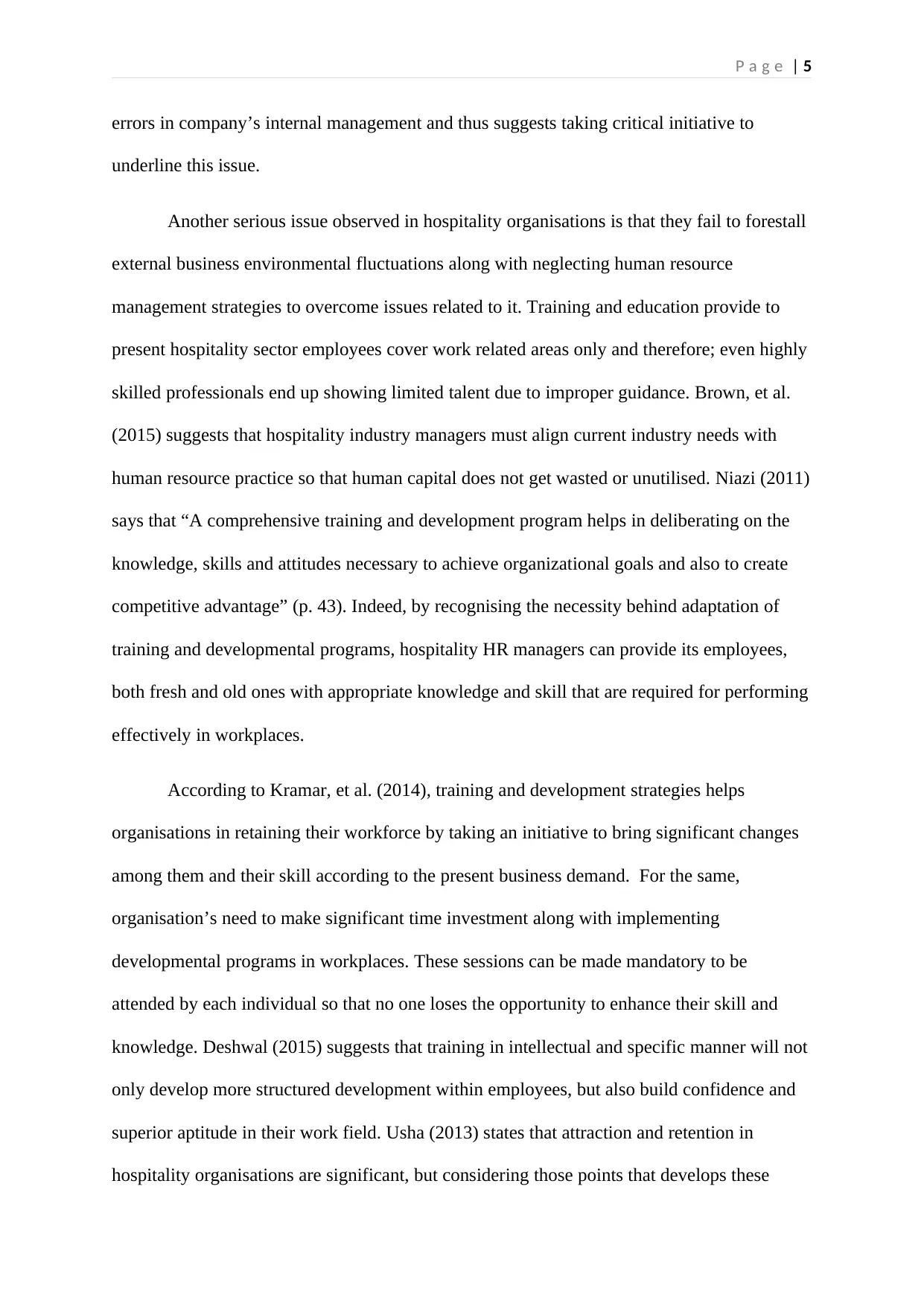
P a g e | 5
errors in company’s internal management and thus suggests taking critical initiative to
underline this issue.
Another serious issue observed in hospitality organisations is that they fail to forestall
external business environmental fluctuations along with neglecting human resource
management strategies to overcome issues related to it. Training and education provide to
present hospitality sector employees cover work related areas only and therefore; even highly
skilled professionals end up showing limited talent due to improper guidance. Brown, et al.
(2015) suggests that hospitality industry managers must align current industry needs with
human resource practice so that human capital does not get wasted or unutilised. Niazi (2011)
says that “A comprehensive training and development program helps in deliberating on the
knowledge, skills and attitudes necessary to achieve organizational goals and also to create
competitive advantage” (p. 43). Indeed, by recognising the necessity behind adaptation of
training and developmental programs, hospitality HR managers can provide its employees,
both fresh and old ones with appropriate knowledge and skill that are required for performing
effectively in workplaces.
According to Kramar, et al. (2014), training and development strategies helps
organisations in retaining their workforce by taking an initiative to bring significant changes
among them and their skill according to the present business demand. For the same,
organisation’s need to make significant time investment along with implementing
developmental programs in workplaces. These sessions can be made mandatory to be
attended by each individual so that no one loses the opportunity to enhance their skill and
knowledge. Deshwal (2015) suggests that training in intellectual and specific manner will not
only develop more structured development within employees, but also build confidence and
superior aptitude in their work field. Usha (2013) states that attraction and retention in
hospitality organisations are significant, but considering those points that develops these
errors in company’s internal management and thus suggests taking critical initiative to
underline this issue.
Another serious issue observed in hospitality organisations is that they fail to forestall
external business environmental fluctuations along with neglecting human resource
management strategies to overcome issues related to it. Training and education provide to
present hospitality sector employees cover work related areas only and therefore; even highly
skilled professionals end up showing limited talent due to improper guidance. Brown, et al.
(2015) suggests that hospitality industry managers must align current industry needs with
human resource practice so that human capital does not get wasted or unutilised. Niazi (2011)
says that “A comprehensive training and development program helps in deliberating on the
knowledge, skills and attitudes necessary to achieve organizational goals and also to create
competitive advantage” (p. 43). Indeed, by recognising the necessity behind adaptation of
training and developmental programs, hospitality HR managers can provide its employees,
both fresh and old ones with appropriate knowledge and skill that are required for performing
effectively in workplaces.
According to Kramar, et al. (2014), training and development strategies helps
organisations in retaining their workforce by taking an initiative to bring significant changes
among them and their skill according to the present business demand. For the same,
organisation’s need to make significant time investment along with implementing
developmental programs in workplaces. These sessions can be made mandatory to be
attended by each individual so that no one loses the opportunity to enhance their skill and
knowledge. Deshwal (2015) suggests that training in intellectual and specific manner will not
only develop more structured development within employees, but also build confidence and
superior aptitude in their work field. Usha (2013) states that attraction and retention in
hospitality organisations are significant, but considering those points that develops these

P a g e | 6
issues are also important. Here it can be noted that retaining people who are unable to fulfil
organisational objectives becomes useless point and thus merely stating reasons for
organisational inefficiency is unjust. Therefore, Arasli, et al. (2017) suggests that hospitality
organisations must consider implementing training and development programs so that
workforce are trained and developed according to the organisational need.
Work life balance (WLB) is another significant issue that have been seen arising since
past few decades. According to a study made by Farrell (2015), employees’ satisfaction has
reduced up to 10% in between 1999 and 2010. Deprived work life balance not only affects
employee motivation to work more, but also affects their physical and mental health. WLB,
according to Biswakarma et al. (2015) can be well-defined as individual control over
themselves in their work place where satisfaction and good functioning at work as well as
home is maintained with least role conflicts. In contemporary organisations, managing people
along with their WLB strategies is considered as priority in HRM. In fact, many country
governments are also taking initiative to introduce WLB in organisations by mandating WLB
standards and policy framework related to WLB into their business code of conduct.
Organisations who fails to understand their employee’s family needs along with neglecting
health related issues also falls under ethical stance ( Kramar, et al., 2014). Successful WLB
implementation can be made possible through making cost investments as organisations may
have to reduce work load or give additional holidays so that individuals get sufficient time for
themselves as well as for their family. To ground business policies more ethically, HRM
managers need to implement human welfare programs to make employees aware about work
life related frameworks and how to maintain it (Biswakarma, Sandilyan, & Mukherjee, 2015).
Hospitality industry employees have to undertake several responsibilities, even
working for excessive time period more than anticipated. For example, during the times of
holidays and festivals, hotels and tourists’ spots get flooded by visitors and for which
issues are also important. Here it can be noted that retaining people who are unable to fulfil
organisational objectives becomes useless point and thus merely stating reasons for
organisational inefficiency is unjust. Therefore, Arasli, et al. (2017) suggests that hospitality
organisations must consider implementing training and development programs so that
workforce are trained and developed according to the organisational need.
Work life balance (WLB) is another significant issue that have been seen arising since
past few decades. According to a study made by Farrell (2015), employees’ satisfaction has
reduced up to 10% in between 1999 and 2010. Deprived work life balance not only affects
employee motivation to work more, but also affects their physical and mental health. WLB,
according to Biswakarma et al. (2015) can be well-defined as individual control over
themselves in their work place where satisfaction and good functioning at work as well as
home is maintained with least role conflicts. In contemporary organisations, managing people
along with their WLB strategies is considered as priority in HRM. In fact, many country
governments are also taking initiative to introduce WLB in organisations by mandating WLB
standards and policy framework related to WLB into their business code of conduct.
Organisations who fails to understand their employee’s family needs along with neglecting
health related issues also falls under ethical stance ( Kramar, et al., 2014). Successful WLB
implementation can be made possible through making cost investments as organisations may
have to reduce work load or give additional holidays so that individuals get sufficient time for
themselves as well as for their family. To ground business policies more ethically, HRM
managers need to implement human welfare programs to make employees aware about work
life related frameworks and how to maintain it (Biswakarma, Sandilyan, & Mukherjee, 2015).
Hospitality industry employees have to undertake several responsibilities, even
working for excessive time period more than anticipated. For example, during the times of
holidays and festivals, hotels and tourists’ spots get flooded by visitors and for which
Paraphrase This Document
Need a fresh take? Get an instant paraphrase of this document with our AI Paraphraser
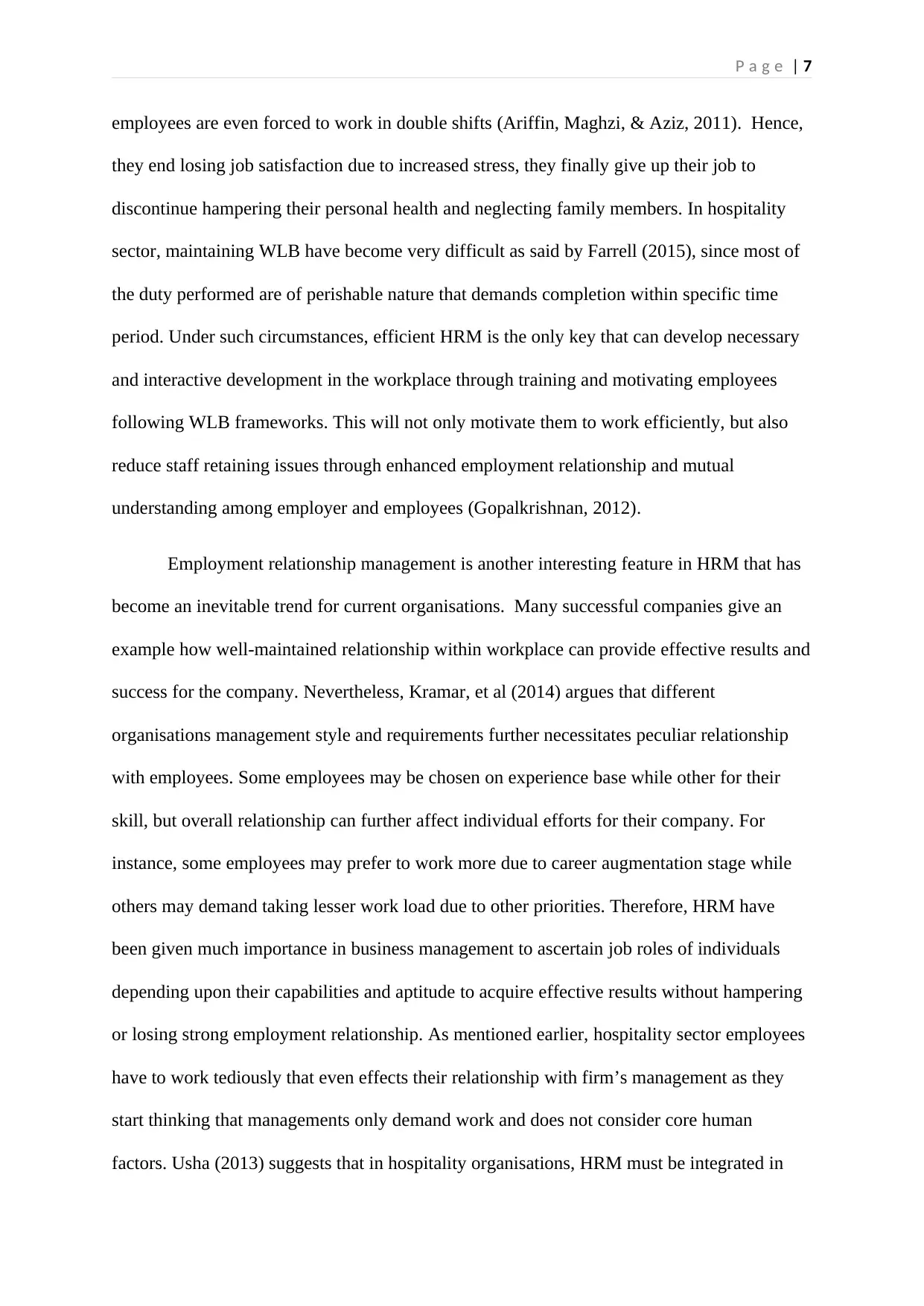
P a g e | 7
employees are even forced to work in double shifts (Ariffin, Maghzi, & Aziz, 2011). Hence,
they end losing job satisfaction due to increased stress, they finally give up their job to
discontinue hampering their personal health and neglecting family members. In hospitality
sector, maintaining WLB have become very difficult as said by Farrell (2015), since most of
the duty performed are of perishable nature that demands completion within specific time
period. Under such circumstances, efficient HRM is the only key that can develop necessary
and interactive development in the workplace through training and motivating employees
following WLB frameworks. This will not only motivate them to work efficiently, but also
reduce staff retaining issues through enhanced employment relationship and mutual
understanding among employer and employees (Gopalkrishnan, 2012).
Employment relationship management is another interesting feature in HRM that has
become an inevitable trend for current organisations. Many successful companies give an
example how well-maintained relationship within workplace can provide effective results and
success for the company. Nevertheless, Kramar, et al (2014) argues that different
organisations management style and requirements further necessitates peculiar relationship
with employees. Some employees may be chosen on experience base while other for their
skill, but overall relationship can further affect individual efforts for their company. For
instance, some employees may prefer to work more due to career augmentation stage while
others may demand taking lesser work load due to other priorities. Therefore, HRM have
been given much importance in business management to ascertain job roles of individuals
depending upon their capabilities and aptitude to acquire effective results without hampering
or losing strong employment relationship. As mentioned earlier, hospitality sector employees
have to work tediously that even effects their relationship with firm’s management as they
start thinking that managements only demand work and does not consider core human
factors. Usha (2013) suggests that in hospitality organisations, HRM must be integrated in
employees are even forced to work in double shifts (Ariffin, Maghzi, & Aziz, 2011). Hence,
they end losing job satisfaction due to increased stress, they finally give up their job to
discontinue hampering their personal health and neglecting family members. In hospitality
sector, maintaining WLB have become very difficult as said by Farrell (2015), since most of
the duty performed are of perishable nature that demands completion within specific time
period. Under such circumstances, efficient HRM is the only key that can develop necessary
and interactive development in the workplace through training and motivating employees
following WLB frameworks. This will not only motivate them to work efficiently, but also
reduce staff retaining issues through enhanced employment relationship and mutual
understanding among employer and employees (Gopalkrishnan, 2012).
Employment relationship management is another interesting feature in HRM that has
become an inevitable trend for current organisations. Many successful companies give an
example how well-maintained relationship within workplace can provide effective results and
success for the company. Nevertheless, Kramar, et al (2014) argues that different
organisations management style and requirements further necessitates peculiar relationship
with employees. Some employees may be chosen on experience base while other for their
skill, but overall relationship can further affect individual efforts for their company. For
instance, some employees may prefer to work more due to career augmentation stage while
others may demand taking lesser work load due to other priorities. Therefore, HRM have
been given much importance in business management to ascertain job roles of individuals
depending upon their capabilities and aptitude to acquire effective results without hampering
or losing strong employment relationship. As mentioned earlier, hospitality sector employees
have to work tediously that even effects their relationship with firm’s management as they
start thinking that managements only demand work and does not consider core human
factors. Usha (2013) suggests that in hospitality organisations, HRM must be integrated in
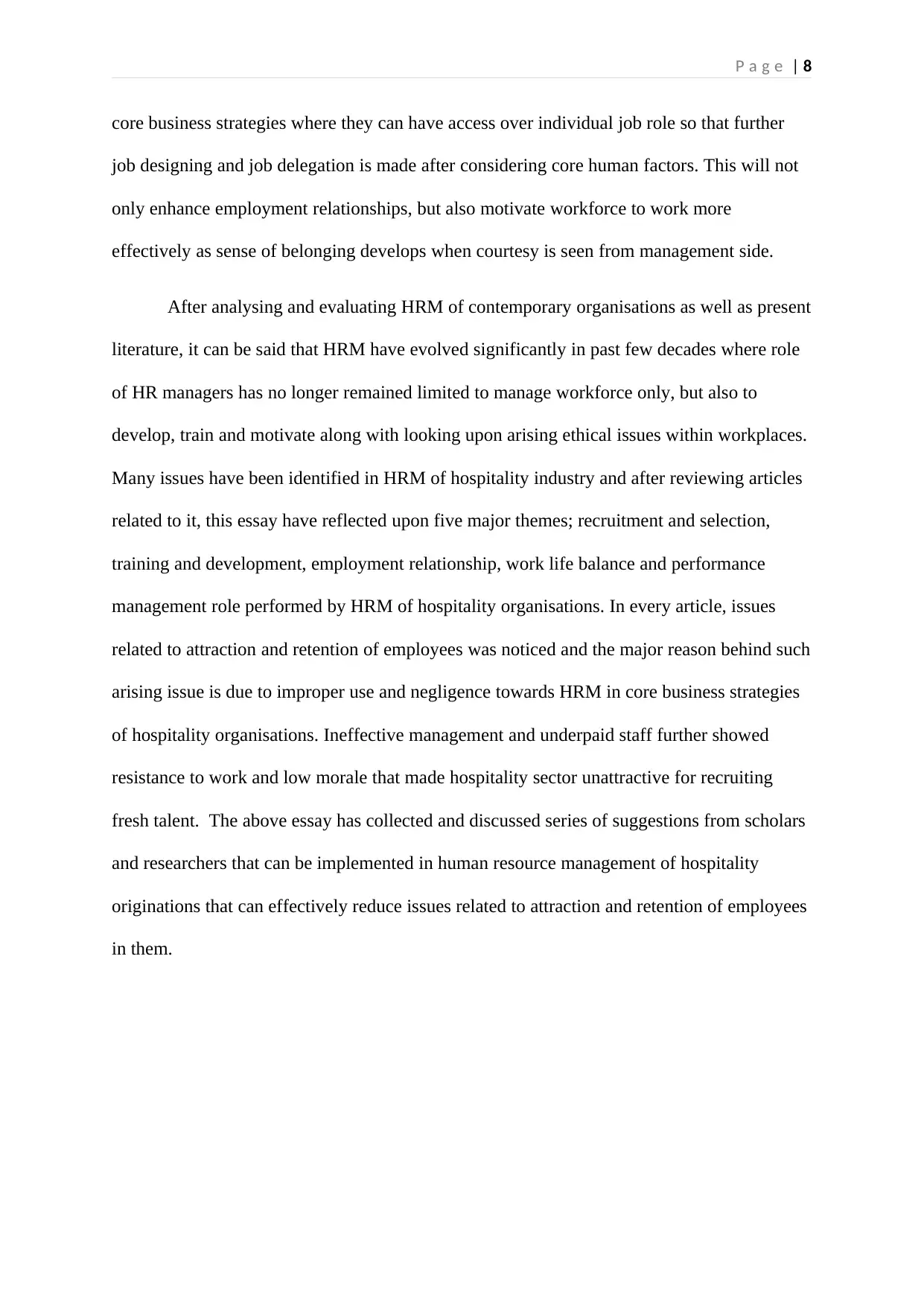
P a g e | 8
core business strategies where they can have access over individual job role so that further
job designing and job delegation is made after considering core human factors. This will not
only enhance employment relationships, but also motivate workforce to work more
effectively as sense of belonging develops when courtesy is seen from management side.
After analysing and evaluating HRM of contemporary organisations as well as present
literature, it can be said that HRM have evolved significantly in past few decades where role
of HR managers has no longer remained limited to manage workforce only, but also to
develop, train and motivate along with looking upon arising ethical issues within workplaces.
Many issues have been identified in HRM of hospitality industry and after reviewing articles
related to it, this essay have reflected upon five major themes; recruitment and selection,
training and development, employment relationship, work life balance and performance
management role performed by HRM of hospitality organisations. In every article, issues
related to attraction and retention of employees was noticed and the major reason behind such
arising issue is due to improper use and negligence towards HRM in core business strategies
of hospitality organisations. Ineffective management and underpaid staff further showed
resistance to work and low morale that made hospitality sector unattractive for recruiting
fresh talent. The above essay has collected and discussed series of suggestions from scholars
and researchers that can be implemented in human resource management of hospitality
originations that can effectively reduce issues related to attraction and retention of employees
in them.
core business strategies where they can have access over individual job role so that further
job designing and job delegation is made after considering core human factors. This will not
only enhance employment relationships, but also motivate workforce to work more
effectively as sense of belonging develops when courtesy is seen from management side.
After analysing and evaluating HRM of contemporary organisations as well as present
literature, it can be said that HRM have evolved significantly in past few decades where role
of HR managers has no longer remained limited to manage workforce only, but also to
develop, train and motivate along with looking upon arising ethical issues within workplaces.
Many issues have been identified in HRM of hospitality industry and after reviewing articles
related to it, this essay have reflected upon five major themes; recruitment and selection,
training and development, employment relationship, work life balance and performance
management role performed by HRM of hospitality organisations. In every article, issues
related to attraction and retention of employees was noticed and the major reason behind such
arising issue is due to improper use and negligence towards HRM in core business strategies
of hospitality organisations. Ineffective management and underpaid staff further showed
resistance to work and low morale that made hospitality sector unattractive for recruiting
fresh talent. The above essay has collected and discussed series of suggestions from scholars
and researchers that can be implemented in human resource management of hospitality
originations that can effectively reduce issues related to attraction and retention of employees
in them.
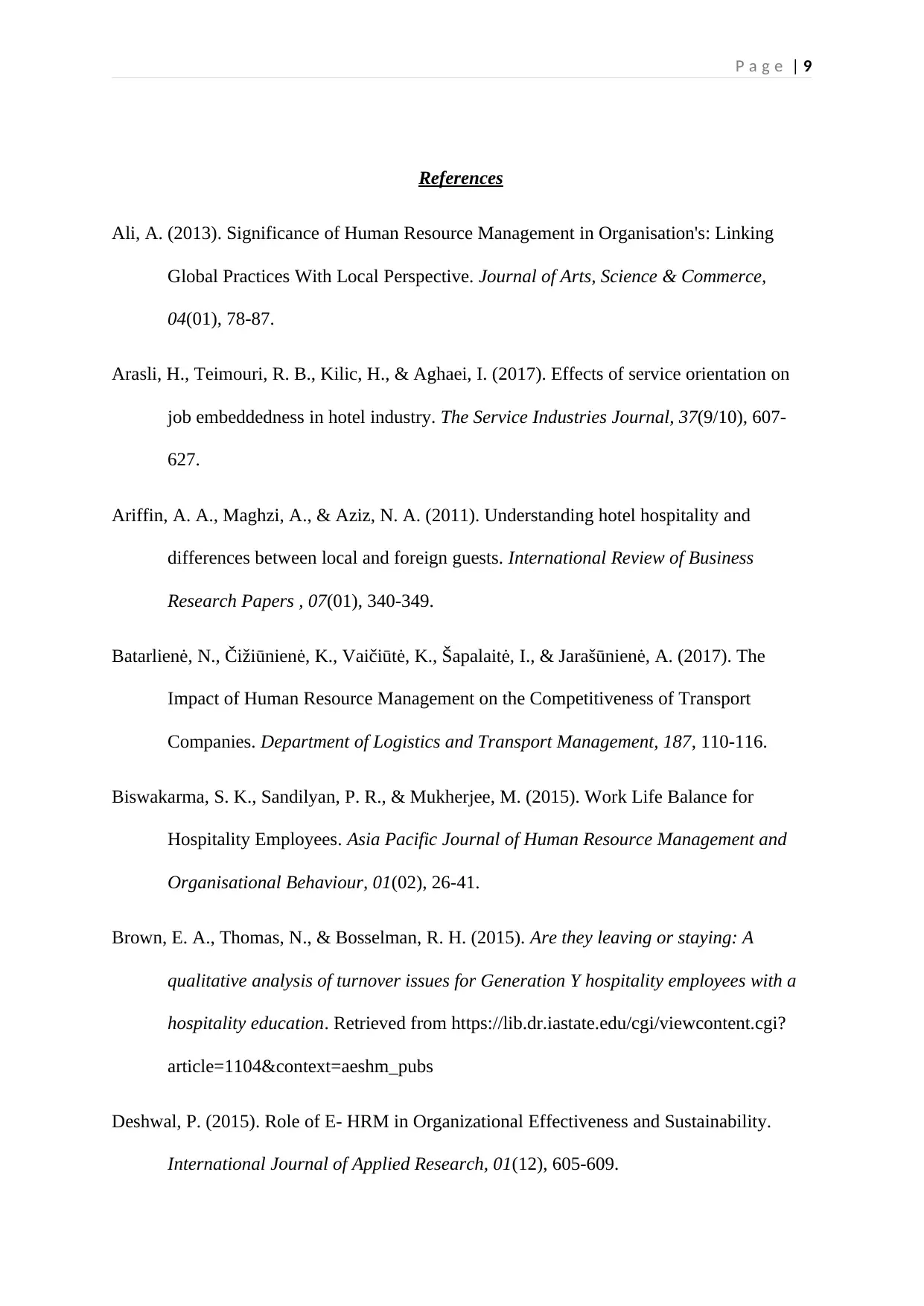
P a g e | 9
References
Ali, A. (2013). Significance of Human Resource Management in Organisation's: Linking
Global Practices With Local Perspective. Journal of Arts, Science & Commerce,
04(01), 78-87.
Arasli, H., Teimouri, R. B., Kilic, H., & Aghaei, I. (2017). Effects of service orientation on
job embeddedness in hotel industry. The Service Industries Journal, 37(9/10), 607-
627.
Ariffin, A. A., Maghzi, A., & Aziz, N. A. (2011). Understanding hotel hospitality and
differences between local and foreign guests. International Review of Business
Research Papers , 07(01), 340-349.
Batarlienė, N., Čižiūnienė, K., Vaičiūtė, K., Šapalaitė, I., & Jarašūnienė, A. (2017). The
Impact of Human Resource Management on the Competitiveness of Transport
Companies. Department of Logistics and Transport Management, 187, 110-116.
Biswakarma, S. K., Sandilyan, P. R., & Mukherjee, M. (2015). Work Life Balance for
Hospitality Employees. Asia Pacific Journal of Human Resource Management and
Organisational Behaviour, 01(02), 26-41.
Brown, E. A., Thomas, N., & Bosselman, R. H. (2015). Are they leaving or staying: A
qualitative analysis of turnover issues for Generation Y hospitality employees with a
hospitality education. Retrieved from https://lib.dr.iastate.edu/cgi/viewcontent.cgi?
article=1104&context=aeshm_pubs
Deshwal, P. (2015). Role of E- HRM in Organizational Effectiveness and Sustainability.
International Journal of Applied Research, 01(12), 605-609.
References
Ali, A. (2013). Significance of Human Resource Management in Organisation's: Linking
Global Practices With Local Perspective. Journal of Arts, Science & Commerce,
04(01), 78-87.
Arasli, H., Teimouri, R. B., Kilic, H., & Aghaei, I. (2017). Effects of service orientation on
job embeddedness in hotel industry. The Service Industries Journal, 37(9/10), 607-
627.
Ariffin, A. A., Maghzi, A., & Aziz, N. A. (2011). Understanding hotel hospitality and
differences between local and foreign guests. International Review of Business
Research Papers , 07(01), 340-349.
Batarlienė, N., Čižiūnienė, K., Vaičiūtė, K., Šapalaitė, I., & Jarašūnienė, A. (2017). The
Impact of Human Resource Management on the Competitiveness of Transport
Companies. Department of Logistics and Transport Management, 187, 110-116.
Biswakarma, S. K., Sandilyan, P. R., & Mukherjee, M. (2015). Work Life Balance for
Hospitality Employees. Asia Pacific Journal of Human Resource Management and
Organisational Behaviour, 01(02), 26-41.
Brown, E. A., Thomas, N., & Bosselman, R. H. (2015). Are they leaving or staying: A
qualitative analysis of turnover issues for Generation Y hospitality employees with a
hospitality education. Retrieved from https://lib.dr.iastate.edu/cgi/viewcontent.cgi?
article=1104&context=aeshm_pubs
Deshwal, P. (2015). Role of E- HRM in Organizational Effectiveness and Sustainability.
International Journal of Applied Research, 01(12), 605-609.
Secure Best Marks with AI Grader
Need help grading? Try our AI Grader for instant feedback on your assignments.
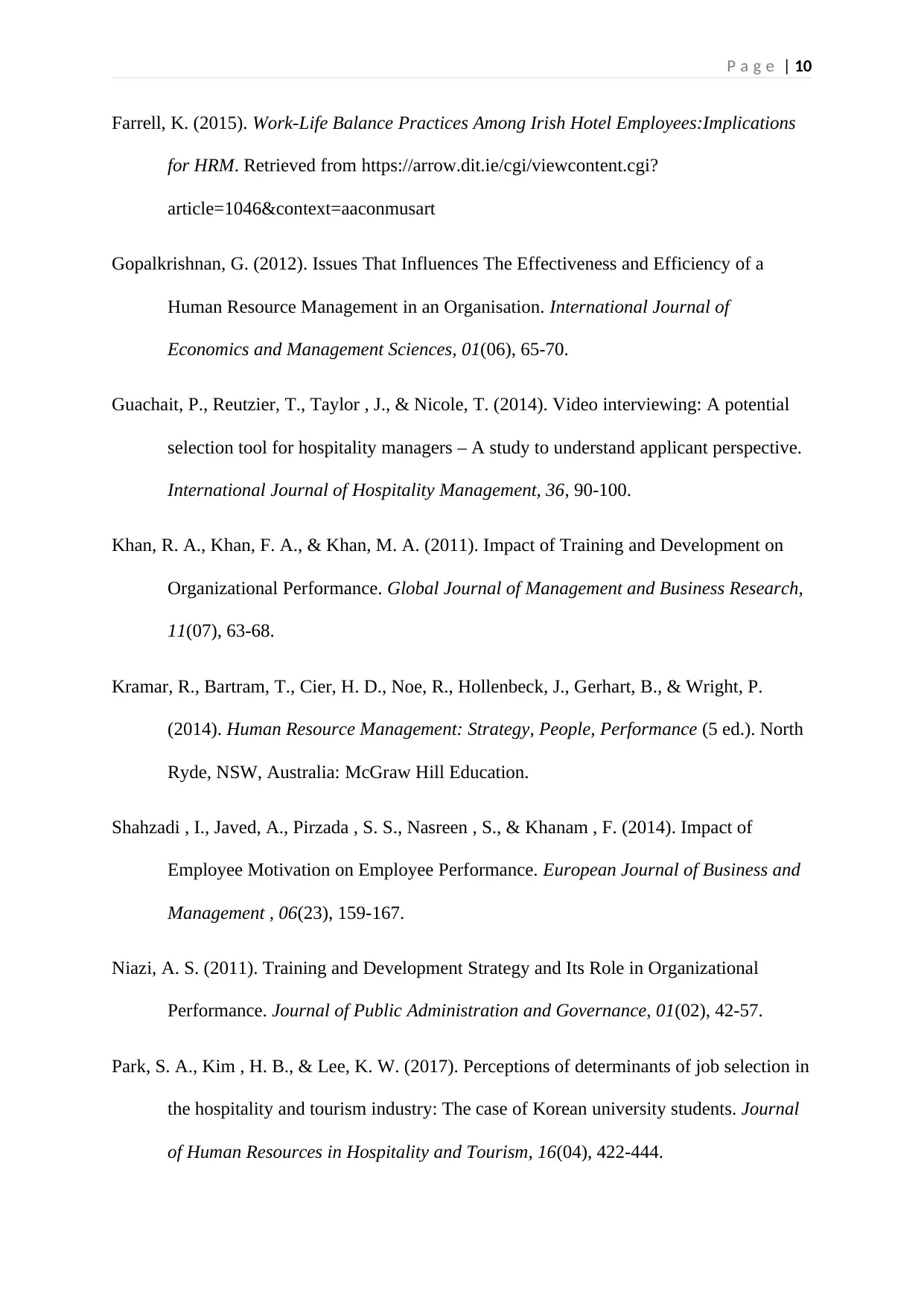
P a g e | 10
Farrell, K. (2015). Work-Life Balance Practices Among Irish Hotel Employees:Implications
for HRM. Retrieved from https://arrow.dit.ie/cgi/viewcontent.cgi?
article=1046&context=aaconmusart
Gopalkrishnan, G. (2012). Issues That Influences The Effectiveness and Efficiency of a
Human Resource Management in an Organisation. International Journal of
Economics and Management Sciences, 01(06), 65-70.
Guachait, P., Reutzier, T., Taylor , J., & Nicole, T. (2014). Video interviewing: A potential
selection tool for hospitality managers – A study to understand applicant perspective.
International Journal of Hospitality Management, 36, 90-100.
Khan, R. A., Khan, F. A., & Khan, M. A. (2011). Impact of Training and Development on
Organizational Performance. Global Journal of Management and Business Research,
11(07), 63-68.
Kramar, R., Bartram, T., Cier, H. D., Noe, R., Hollenbeck, J., Gerhart, B., & Wright, P.
(2014). Human Resource Management: Strategy, People, Performance (5 ed.). North
Ryde, NSW, Australia: McGraw Hill Education.
Shahzadi , I., Javed, A., Pirzada , S. S., Nasreen , S., & Khanam , F. (2014). Impact of
Employee Motivation on Employee Performance. European Journal of Business and
Management , 06(23), 159-167.
Niazi, A. S. (2011). Training and Development Strategy and Its Role in Organizational
Performance. Journal of Public Administration and Governance, 01(02), 42-57.
Park, S. A., Kim , H. B., & Lee, K. W. (2017). Perceptions of determinants of job selection in
the hospitality and tourism industry: The case of Korean university students. Journal
of Human Resources in Hospitality and Tourism, 16(04), 422-444.
Farrell, K. (2015). Work-Life Balance Practices Among Irish Hotel Employees:Implications
for HRM. Retrieved from https://arrow.dit.ie/cgi/viewcontent.cgi?
article=1046&context=aaconmusart
Gopalkrishnan, G. (2012). Issues That Influences The Effectiveness and Efficiency of a
Human Resource Management in an Organisation. International Journal of
Economics and Management Sciences, 01(06), 65-70.
Guachait, P., Reutzier, T., Taylor , J., & Nicole, T. (2014). Video interviewing: A potential
selection tool for hospitality managers – A study to understand applicant perspective.
International Journal of Hospitality Management, 36, 90-100.
Khan, R. A., Khan, F. A., & Khan, M. A. (2011). Impact of Training and Development on
Organizational Performance. Global Journal of Management and Business Research,
11(07), 63-68.
Kramar, R., Bartram, T., Cier, H. D., Noe, R., Hollenbeck, J., Gerhart, B., & Wright, P.
(2014). Human Resource Management: Strategy, People, Performance (5 ed.). North
Ryde, NSW, Australia: McGraw Hill Education.
Shahzadi , I., Javed, A., Pirzada , S. S., Nasreen , S., & Khanam , F. (2014). Impact of
Employee Motivation on Employee Performance. European Journal of Business and
Management , 06(23), 159-167.
Niazi, A. S. (2011). Training and Development Strategy and Its Role in Organizational
Performance. Journal of Public Administration and Governance, 01(02), 42-57.
Park, S. A., Kim , H. B., & Lee, K. W. (2017). Perceptions of determinants of job selection in
the hospitality and tourism industry: The case of Korean university students. Journal
of Human Resources in Hospitality and Tourism, 16(04), 422-444.
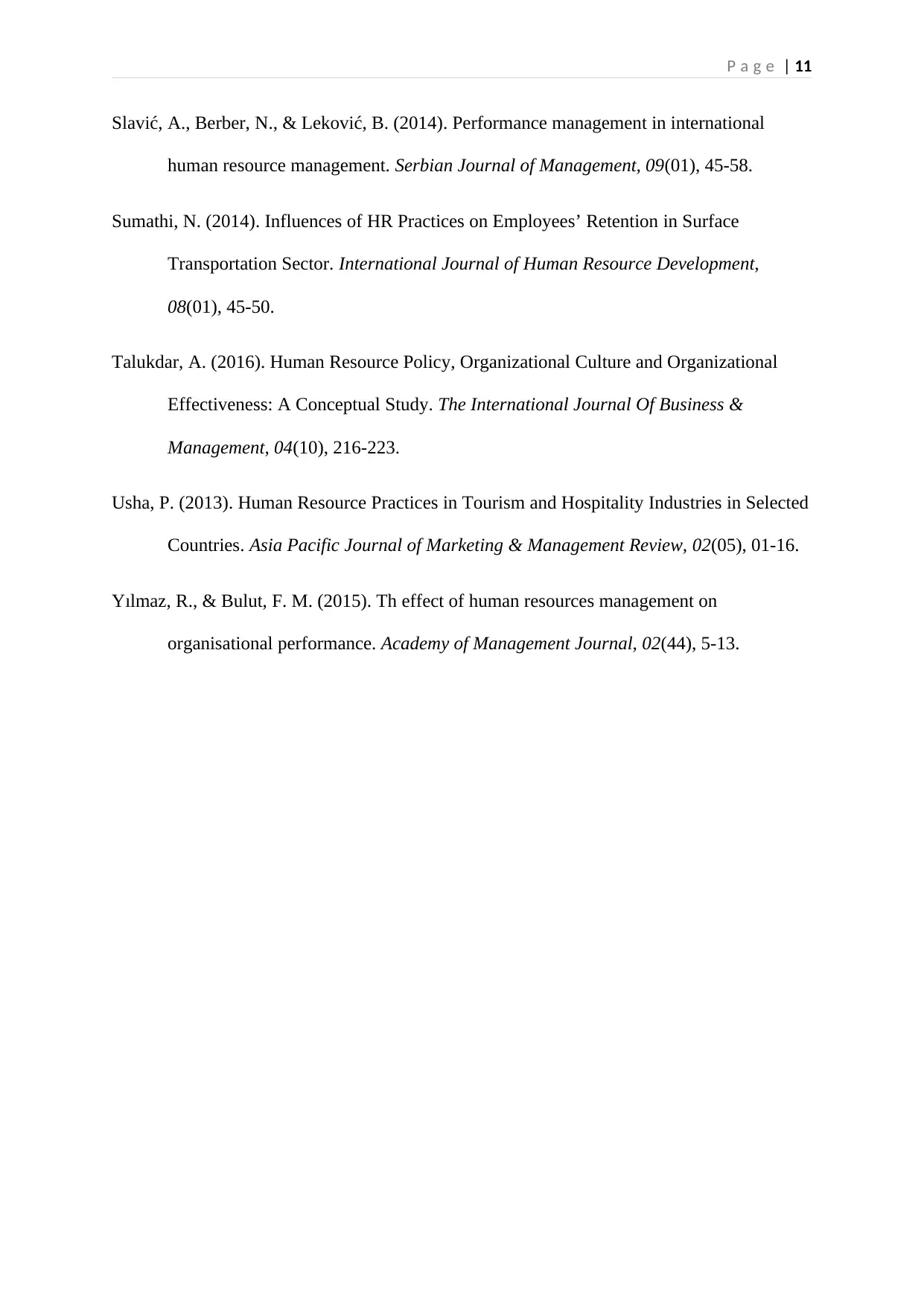
P a g e | 11
Slavić, A., Berber, N., & Leković, B. (2014). Performance management in international
human resource management. Serbian Journal of Management, 09(01), 45-58.
Sumathi, N. (2014). Influences of HR Practices on Employees’ Retention in Surface
Transportation Sector. International Journal of Human Resource Development,
08(01), 45-50.
Talukdar, A. (2016). Human Resource Policy, Organizational Culture and Organizational
Effectiveness: A Conceptual Study. The International Journal Of Business &
Management, 04(10), 216-223.
Usha, P. (2013). Human Resource Practices in Tourism and Hospitality Industries in Selected
Countries. Asia Pacific Journal of Marketing & Management Review, 02(05), 01-16.
Yılmaz, R., & Bulut, F. M. (2015). Th effect of human resources management on
organisational performance. Academy of Management Journal, 02(44), 5-13.
Slavić, A., Berber, N., & Leković, B. (2014). Performance management in international
human resource management. Serbian Journal of Management, 09(01), 45-58.
Sumathi, N. (2014). Influences of HR Practices on Employees’ Retention in Surface
Transportation Sector. International Journal of Human Resource Development,
08(01), 45-50.
Talukdar, A. (2016). Human Resource Policy, Organizational Culture and Organizational
Effectiveness: A Conceptual Study. The International Journal Of Business &
Management, 04(10), 216-223.
Usha, P. (2013). Human Resource Practices in Tourism and Hospitality Industries in Selected
Countries. Asia Pacific Journal of Marketing & Management Review, 02(05), 01-16.
Yılmaz, R., & Bulut, F. M. (2015). Th effect of human resources management on
organisational performance. Academy of Management Journal, 02(44), 5-13.
1 out of 12
Related Documents
Your All-in-One AI-Powered Toolkit for Academic Success.
+13062052269
info@desklib.com
Available 24*7 on WhatsApp / Email
![[object Object]](/_next/static/media/star-bottom.7253800d.svg)
Unlock your academic potential
© 2024 | Zucol Services PVT LTD | All rights reserved.





